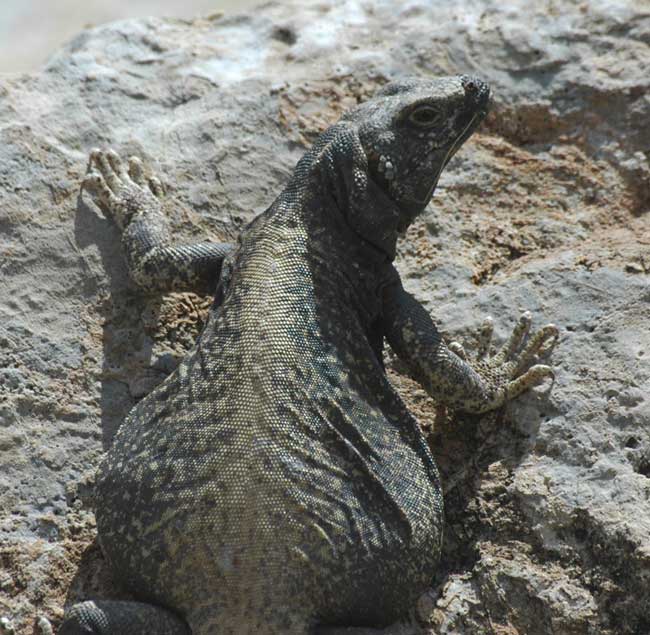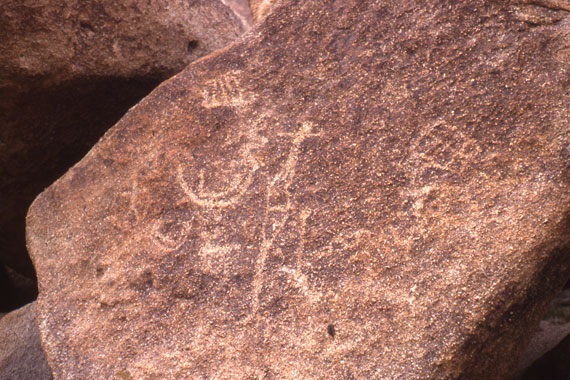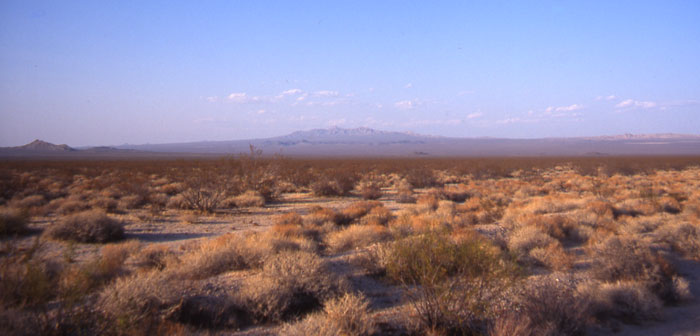Problems with Industrial-Scale Renewables
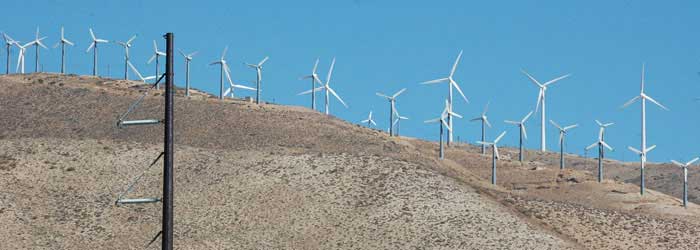
Wind: touted as a clean, green form of renewable energy, the actual on-the-ground picture looks otherwise. Renewable - yes. But "clean and green" - not necessarily.
The proposed Searchlight Wind Project (>>see here) serves as an example for analysis of the details of utility-scale industrial wind energy far from sources of consumption (cities), in a thriving desert ecosystem with rare wildlife habitat and surrounding wilderness areas. Will the local town benefit? How much energy will actually be produced? Will the viewscape from nearby wilderness ranges be compromised? What will the company do to mitigate Desert tortoise and Bighorn sheep disturbances? We'll take a look at these and other issues.
After reading through the Plan of Development (POD) prepared for the Catamount Energy Corporation and so quickly released by the Bureau of Land management (BLM), we have a long list of comments concerning the surprising lack of information in the document. We also have several suggestions for BLM to put in the Environmental Impact Statement (EIS). We are also wondering why the BLM rushed such an incomplete plan through so quickly. We would like to think the BLM is not trying to streamline a project that has so many impacts through as quickly as possible. The large impact and footprint that this will leave on the scenery, flora and fauna, as well as the potential disturbance of private property values is of obvious concern to anyone who cares about the Mojave Desert. And this is not just a local desert issue: thousands of wind farms have been proposed all over the country, on Appalachian ridges, across the Great Plains, by National Parks. Issues like this will be coming to towns and parks like yours.

Justifying Large Wind Farms
POD: “The purpose of this project is to create an economically viable source of clean renewable electricity generation that meets Nevada’s growing demand for power and fulfills the many state and national renewable energy policies. The proposed project will be located in Clark County, which was among the five fastest growing counties in the United States in terms of population growth from 2000 to 2005 according to US Census Bureau data. “
Our Response: This is out dated information. As of December 23, 2008, the US Census Bureau ranked Nevada 8 in the nation’s growth. It has clearly changed since 2005. The growth boom tapered off in 2007 and has continued to decline. This does not justify an energy need for such a project that will have such critical impacts to the environment and way of life for people in the area. This needs to be updated to current growth rates. In addition, high-efficiency home standards could save Nevada electric companies huge amounts without building government-subsidized corporate boondoggles.
Independent government policy analyst Glenn Schleede breaks down the numbers this way: in 2004, there were 15,000 windmills in 30 states In the US, with a total generating capacity of 6,740 megawatts (MW). If those thousands of windmills averaged a generous 27% capacity factor, the total amount of electricity they would produce annually would be 15,941,448,000 kilowatt-hours. This is equal to only 0.41% of the electricity produced in the US during 2003. (From www.aweo.org, "Big money" discovers the huge tax breaks and subsidies for wind energy while taxpayers and electric customers pick up the tab, Glenn Schleede, April 14, 2005). The American Wind Energy Association said in 2008 that wind now generates 20,000 MW - still generating only a few percent of national production.
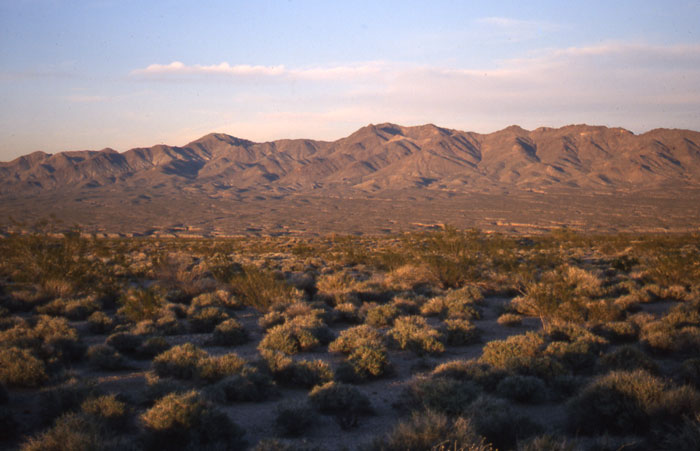
^Searchlight area and the Piute-ElDorado Area of Critical Environmental Concern. Industrial wind turbines will line this horizon.
POD: “The Searchlight, Nevada vicinity is identified as an area of significant wind resource potential by the National Renewable Energy Laboratory wind map for the state of Nevada, and wind energy testing with on site meteorological towers is currently being conducted within the area proposed for development by Catamount.”
Our Response: The Department of Energy’s wind program and the National Renewable Energy Laboratory (NREL) published a map of the wind energy potential of Nevada. It only calls the Searchlight area as “fair” wind potential. We can not see the justification of a $600 million wind farm the will damage so much of the landscape for only a “fair” wind potential. The link to the map is here. How will Catamount supplement the energy when the wind is not blowing? Will there be other massive alternative energy farms? Will there be natural gas pipelines? Will other energy facilities require additional land disturbance and powerlines? Will the BLM give us a good idea of how much development it will take to connect an inefficient energy producing wind facility with other energy facilities? This needs to be in the EIS.

^Government map showing the Searchlight area as no better than "fair" for wind power potential.
POD: "Federal Executive Order 13212 requires all federal agencies to streamline their internal processes for approving energy related projects. The Energy Policy Act of 2005 directs the Department of the Interior, of which the BLM is a part, to take actions to promote the development of domestic renewable energy supplies."
Our Response: This Federal Order says nothing about prioritizing the streamlining process over sound environmental protection. It is the responsibility of the BLM to fully examine the potential impacts such projects will have on the natural resources and local people. BLM will need to take their time and do a professional job of examining all of the problems this may cause.
POD: "Wind is a domestic and local energy source. The project will contribute to domestic energy security; and unlike oil, gas, and coal reserves, the supply of wind does not diminish over time. Wind generation produces electricity without consuming fossil fuels or water and does not produce air emissions, water effluent or hazardous waste. When the wind blows and electricity is generated by a wind farm it displaces energy generated by fossil fuel power generation facilities. This is because large volumes of electricity cannot be stored and to maintain the balance between the supply and demand for electricity, the real-time output required from fossil fuel plants would be reduced by the amount of renewable generation going into the electrical grid. Based on an average capacity factor of 29 percent, the project will result in the approximate savings of 575,000 tons of Carbon Dioxide, 900 tons of Nitrogen Oxide, and 600 tons of Sulfur Dioxide per year compared with electricity generated by the average fuel mix for the region in which the project is to be located."
Our Response: For every megawatt (MW) of wind power installed there needs to be an equal amount of backup energy. Traditionally, this is gas fired or coal fired. Catamount is conveniently excluding any description of backup sources of energy that will be required for this back up. The EIS should list the amount of emissions that will be emitted from any traditional energy that is used for this backup.
Industrial wind turbines generate an average of only a sixth to a third of their rated capacity. They generate at or above that average rate only a third of the time. The output is highly variable, so other sources on the grid must work harder to balance it - that means coal, natural gas, and nuclear. Often the times of high winds do not correspond to times of high electricity demand.
The way the electric grid works is complex: According to the US Department of Energy website, "supply and demand for fuel and transmission, international events and changes in weather also affect the price of your electricity. In most areas, the cost to generate electricity fluctuates daily and monthly. These fluctuations are a response to changes in demand for electricity. Daily demand for electricity is usually highest in the afternoon and early evening (on-peak). Seasonal peaks reflect regional weather and climatic conditions, with the highest occurring in the summer when air-conditioning use is greatest. Power plants tend to operate in two basic modes: base-load and base-load peaking load. Base-load power plants are most efficient generating electricity at an even, consistent level, around the clock, and generally include nuclear, coal-fired, geothermal and waste-to-energy plants. Some plants may sit as a 'spinning reserve' during off-peak or on-peak periods. Peaking plants are turned on or 'dispatched' as demand increases above the normal base demand or load. Peaking plants are expensive to operate, often fueled by refined oil products, or natural gas, and have a fuel cost per kWh higher than a baseload plant" (from www.eia.doe.gov >>here).
At present there is no economically viable way of storing electricity in quantities sufficient to smooth wind power generation through periods of low generation.
According to wind energy critic Eric Rosenbloom (July 7, 2008, www.aweo.org), Denmark makes 20% of its electricity from wind turbines , but no conventional power plant has been shut down as a result. According to the International Energy Agency, natural gas use in Denmark increased more than wind as the latter's turbines went in, and coal use has been on the rise.
LS Power Associates of East Brunswick, N.J., for example, is going ahead with developing a 1,600-megawatt coal-burning power plant, the White Pine Energy Station near Ely, Nevada, as well as a Southwest Intertie Project, a transmission line that could provide the first direct connection between electric utilities in southern Nevada and northern Nevada. The 500-kilovolt transmission line would run 234 miles from Las Vegas to a site near Ely. "Although the power line could carry electricity from the White Pine power plant, the transmission line also could carry geothermal, wind and other kinds of renewable energy." The Las Vegas Review Journal Story is >>here.
LS Power made a statement last summer that they would not be able to get financial backing for their proposed "green" powerline from Ely to Las Vegas unless the coal plant was approved. Senator Reid backed the powerline as green saying it would only be used for wind, solar and geothermal. The problem is the returns on wind and solar do not economically justify the investment for the powerline. The bottom line is that for the economics to work, industrial green energy needs to be backed up by dirty fossil fuels to keep it going when the wind doesn't blow and the sun doesn't shine. This actually makes a case that industrial green energy will add to the whole climate change problem. Utility company officials have said the coal-fired project remains part of their overall strategy for diversified power generation to ensure demand for electricity can be met.
An article in the Las Vegas Sun reported that, Sierra Pacific Resources, Nevada's largest utility and parent company of Nevada Power, "by 2013 could develop 1,442 to 2,337 megawatts — enough power for 1 million to 1.75 million homes — by building a transmission line to tie the Northern and Southern Nevada power grids together for the first time; developing geothermal, wind and solar power; increasing efficiency measures; and creating 300 to 500 megawatts of natural gas-fired power, enough for 225,000 to 375,000 homes. Sierra Pacific Resources has said transmission between the two regions of the state is too expensive to be feasible without a large coal plant. The company plans to build a 250-mile power line from eastern Nevada to Las Vegas in conjunction with its 1,500-megawatt Ely Energy Center, but delays to the Ely plant are also holding up the transmission line....Sierra Pacific Resources President and CEO Michael Yackira has described that strategy as a three-pronged approach of efficiency measures, renewable energy development and traditional fossil fuel plants such as the Ely Energy Center." The transmission line would cost $600 million. (See the article >>here)
Energy Secretary nominee Steven Chu acknowledged the need to pursue nuclear and clean-coal energy at his congressional confirmation hearing. Chu said the United States has an opportunity to develop clean-coal technologies for the rest of the world to use, and "if confirmed, I will work very hard to extensively develop these." He also added, "I'm supportive of the fact that the nuclear industry should be part of the mix." (See the article >>here)
"Greenwashing"
A new term has arisen of late, used to describe the political shenanigans of the power players. Helena, Montana — "That line is in fact going to carry dirty power," explained Ken Toole, Montana’s Public Service Commissioner. The economics of a power line mean that it has to be full all the time, which will be a huge challenge for using only wind and solar power since their output varies over the course of a day and a season.
“I’ve talked with [the company that wants to build the transmission line] about the concept of ‘greenwashing’ these projects. Talking about them as facilitating wind, giving the public the impression that they are all about clean, renewable power – that’s a little misleading,” said Toole.
Montana Governor Brian Schweitzer (D) did not deny that federally funded transmission lines would also help his state’s coal industry. He says he is a strong advocate not just for renewables but for so-called clean coal technologies.
“We’re going to hook some coal into it,” he says. “Fifty percent of the electricity in America comes from coal. I’m all for change, but unless you are willing to live naked in a tree and eat nuts for the next 30 years, coal’s going to be part of the portfolio.”
Larry Swanson, a regional economist at the O’Connor Center for the Rocky Mountain West at the University of Montana in Missoula, revealed that "some proponents of expanding coal-fired electricity production are using windfarms as a rationalization for greatly expanding transmission lines through the region. They talk a lot about wind power, but their real interest is vastly expanded use of coal in generating electricity.”
(See the article in the Christian Science Monitor >>here)
In other words, fossil fuel is not going to go away any time soon.
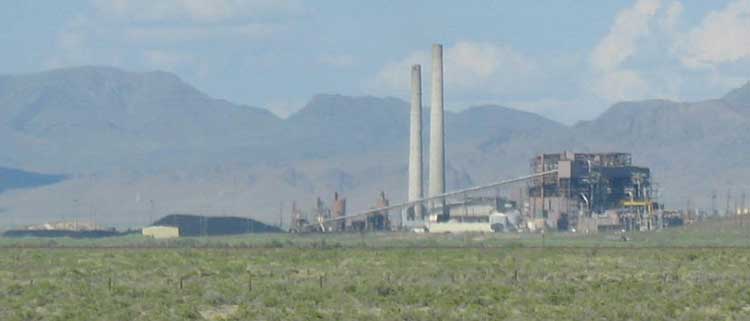
^Coal-burning power plants will continue to be built to back up the uneven production from wind farms. Whether these will be "clean" coal or not is another issue.
Big Footprint
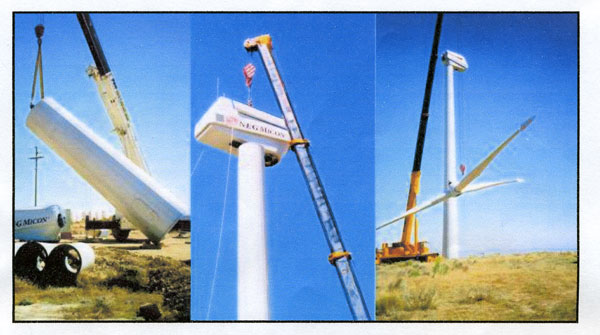
^Placing a wind turbine. These photos and the following are from the Plan of Development (POD) prepared for the Catamount Energy Corporation's proposed Searchlight wind farm.
POD: Facility Design Factors: "Based on the layout of project components ... construction activities will encompass approximately 600 acres of disturbance, which includes approximately 120 acres of permanent disturbance and approximately 480 net acres of temporary disturbance."
Our Response: Many more details are needed. How will Catamount rehabilitate temporarily disturbed areas. Will carbon-sequestering vegetation be replanted?

^Footprint for a single wind turbine base foundation.
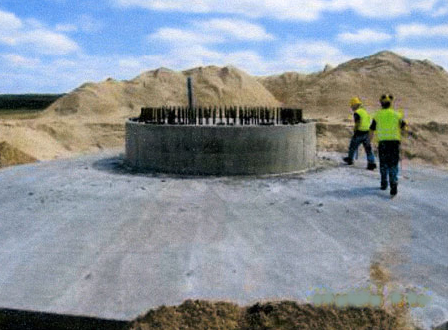
^Turbine base. The base of the steel tower is anchored in a platform of more than a thousand tons of cement and steel rebar, 30 to 50 feet across and anywhere from 6 to 30 feet deep. Pylons may be driven down farther to help anchor the platform.
POD: Wind Turbine Generators: "The proposed wind turbine generators will be the latest generation of three-bladed, upwind, variable speed Siemens 2.3 MW or similar models. The blades, with a 93-meter rotor diameter, will be made of glass-reinforced fiber with steel internal components. The nacelle (or main turbine body), which contains the generator, gearbox, main shaft, bearings, yaw mechanism and various safety systems, will be fully enclosed with a steel chassis and fiberglass covering. Each wind turbine is fully automatic and self-regulating, and has been designed to operate in the high winds and hot conditions of the site. Fully enclosed conical steel tubular towers 80-meters tall will support the turbines and will contain the electronic power and control systems. The wind turbines will be painted a matte, light off-white color, as required by the Federal Aviation Administration."
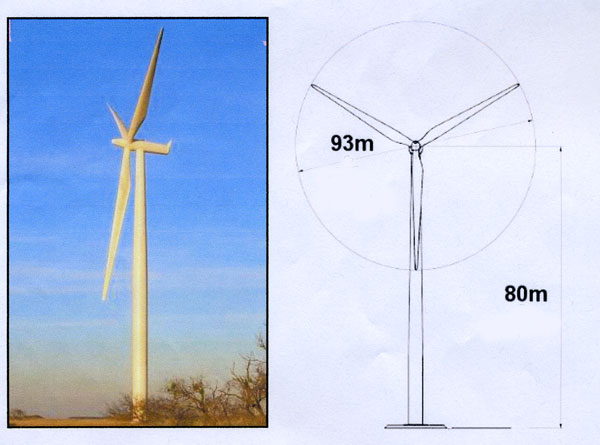
Our Response: The 2.3 MW Siemens SWT-2.3-93 turbines proposed for use at Searchlight, with a tower height of about 240 feet (80m), and turbine radius of approximately 140 feet, have been shown to kill many birds due to the speed of the tip of the blade when turning. The 2.5-megawatt machines proposed for Sheffield and Sutton, for example, have a 256' tower plus a 162' blade radius (with a tip speed of 168 mph) (Eric Rosenbloom, October 31, 2006 [revised August 8, 2007],www.aweo.org) .
The latest technology of large wind turbines may have blades that rotate more slowly than those of older types, but they are much longer and sweep much larger areas. They also reach higher in the sky, killing more species of birds and bats. Furthermore, in spite of their slower rotation, speed at the tip is very high. Mark Duchamp calculated that General Electric model 1.5S has a rotor 70.5-meter-wide (diameter), and a generating rotor-speed varying between 11 and 22 revolutions per minute (rpm) - the tip speed would then be 146 kph. At 22 rpm, the tips go twice as fast: 292 kph. These blade speeds kill birds and bats (Mark Duchamp, www.iberica2000.org).

^Construction of the wind turbine base.
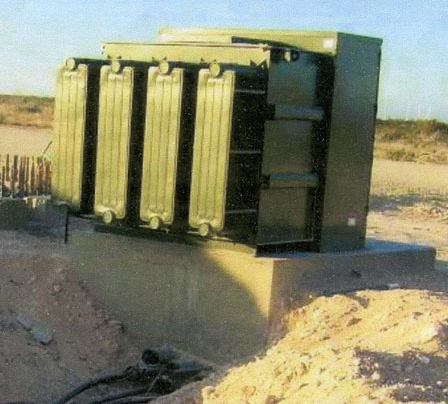
^Turbine pad.
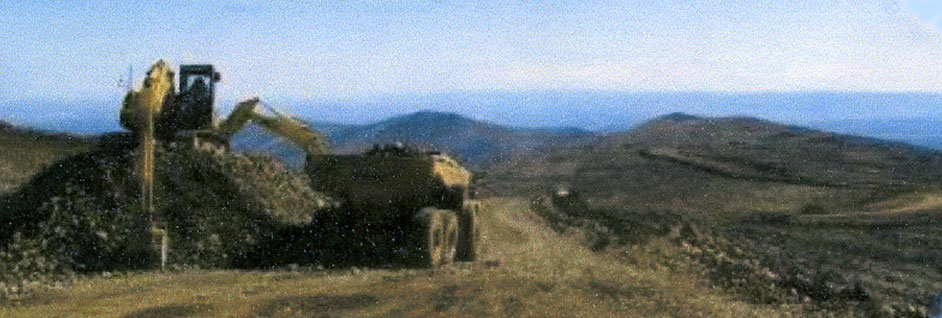
^Ridgeline construction in preparation for wind turbines.
POD: Electrical Collection and Distribution System: "The transmission line can be accessed during construction using all-terrain or off-road vehicles to carry equipment and the poles or towers to their place of erection."
Our Response: The Plan of Development states many times that construction impacts would be minimized and measure would be taken to disturb as little habitat as possible. Yet they propose to use cross country off highway vehicles to get from location to location. It is a known fact the off highway vehicles erode soils, damage plant and wildlife habitat and directly kill flora and fauna. Will Desert tortoises be accidentally run-over?

POD: Meteorological Stations: “Five permanent meteorological masts will be installed to measure the wind speed and direction across the site to compare turbine performance to measured wind speeds over the life of the project....The meteorological stations will be comprised of a free-standing (i.e., will not have guy wires) lattice steel tower of up to 80 meters tall. “
Our Response: The project proposal lies completely on the boundary and some access will be in the Piute-Eldorado Area of Critical Environmental Concern. Having tall towers this close to critical tortoise habitat creates perches for ravens, which are efficient predators of Desert tortoise. This would cause the federal government to start killing the ravens to protect tortoises (as has been done at Edwards Air Force Base), which is extreme.
^Ravens.
POD: Roads: "The project will utilize a mixture of existing federal, state and county and local public roads, as well as new roads constructed for the project. The Site Layout Map... identifies existing roads proposed to be upgraded to support the transport of project facility components, as well as new roads proposed for turbine access and long term operations and maintenance. Primary access to the project will be via U.S. Highway 95 and Nevada State Highway 164. Once off of the primary access routes, the turbines and other facilities will be accessed via upgraded existing roads and new access roads. The project will require upgrades to existing roads across approximately 5.6 miles of BLM land and 1.8 miles of private land. Also, the project will require new roads or crane tracks across approximately 43.7 miles of BLM land and 3.3 miles of private land. An additional 0.5 mile segment of crane track will also be required across BLM land, but will be decommissioned after facility construction is complete....
Existing roads will be upgraded, and new roads constructed, to a width of 36 feet..."
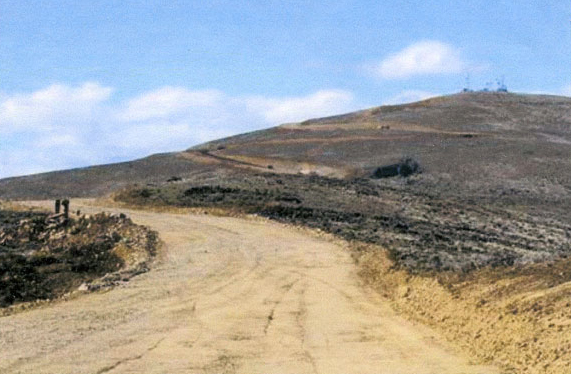
^Road constructed on ridgeline to prepare for wind turbine placement.
Our Response: New graded roads will create more potential for increased mortality of native fauna and cause a potential spread of invasive weeds which may have to be controlled using herbicides.

^A portion of the San Gorgonio wind farm in the Coachella Valley desert of California, showing the number of roads that must be graded into pristine vegetated habitats (Courtesy Matthew Field, www.photography.mattfield.com).
Another issue this creates is the disturbance of private property and a degrading of property values. Making such plans involving 3.3 miles of private lands before even contacting the property owners is irresponsible and inconsiderate.
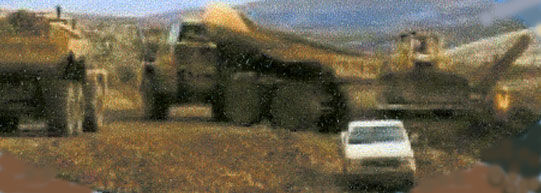
^Heavy machinery at a wind turbine installation.
POD: BLASTING!: "In order to construct the project access roads in the steeper and more topographically dissected lands in the northern and eastern portions of the right-of-way (ROW), it may be necessary to conduct blasting of rock to reach the minimum slope and gradient required for the transportation of turbine components and the crane(s). Blasting may also be required for foundation construction in areas where bedrock exists above the foundation grade level. Each location will be assessed with regard to apparatus or structures in the vicinity, and a determination made of the suitability of that location for blasting. Any foundation or road excavation deemed to be unsafe to blast will be excavated by alternative means, such as a rock-hammer."
Our Response: There will need to be comprehensive information in the EIS on how the blasting will impact surrounding populations of bighorn sheep and other sensitive species such as bats and birds. Information on the best time of year that would have the least impact on particular species will be necessary.
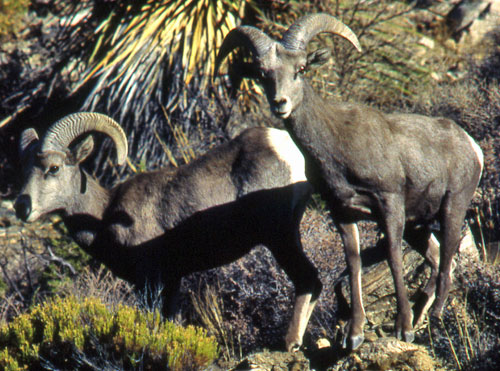
^Desert bighorn rams (Ovis canadensis).

^Road grading on the wind turbine ridge.
POD: TRENCHING FOR UNDERGROUND LINES: "Open trenching is necessary for the placement of electrical collection system cables and fiber optic communication lines. The collection and communications systems will be constructed parallel to the roads running from and between the wind turbines to the project substations and O&M building and will be excavated by a 'Trenching Machine' to a depth of 4 feet and width of 2 feet.... An excavator with a rock hammer attachment or even blasting may be required in areas where rock is at or near the ground surface.
The extent of the open trench at any given time will be minimized to only those distances necessary to conduct work. Once the electric cables and fiber optic communications cable have been placed into the trench... and connected to the wind turbines and transformers (as applicable), the trench will be backfilled with the excavated trench material. In some areas depending upon the thermal resistivity of the excavated soils as determined during the geotechnical investigations, select backfill may be placed around the electric cables to facilitate heat dissipation. In either case backfilling will occur as soon as cable integrity has been tested and confirmed."
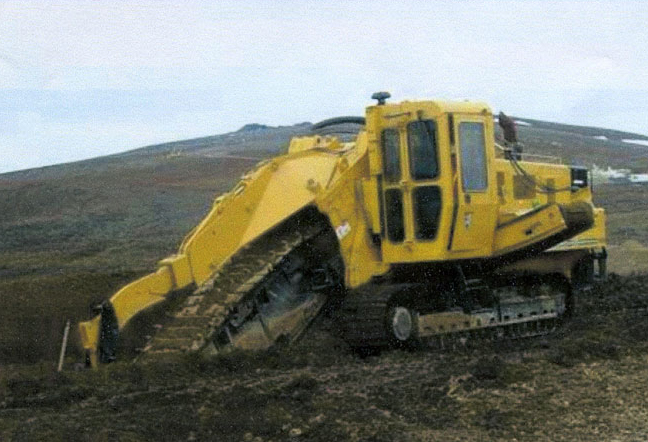
^Trencher at work.
Our Response: The EIS should develop an accurate estimate of how many terrestrial species will be displaced or killed by trenching activity. This will have the potential to kill juvenile tortoises and other species such as the gila monster.
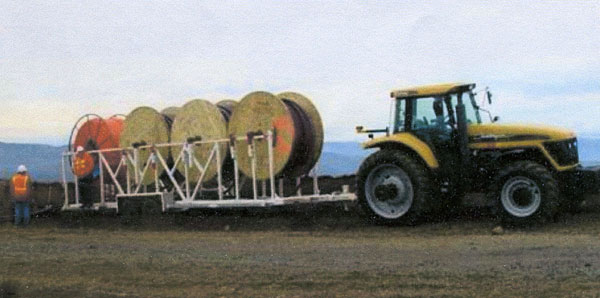
^Laying the underground electric cable.
POD: OVERHEAD DISTRIBUTION/TRANSMISSION LINES: "An above-ground 230 kV overhead transmission line is planned to be routed between the project electrical substations and to the electrical interconnection facility/switchyard to connect with the Western Area Power Administration’s 230 kV Mead – Davis transmission line located southeast of the ROW. The project overhead transmission line will be 7.3 miles in length and will be routed primarily across Federal lands administered by the BLM....The overhead transmission line will comprise electric cable strung from poles or lattice towers ... and the transmission line and poles will include devices to prevent raptor perching. The overhead transmission line will be accessed and installed by truck. A temporary at grade road that will be restored upon completion of the transmission line construction, will be constructed parallel to the transmission line."
Our Response: The transmission lines will have to be insulated to avoid potential electrocution of bird species. We would like to know the details of restoration.

^Installing transmission line.
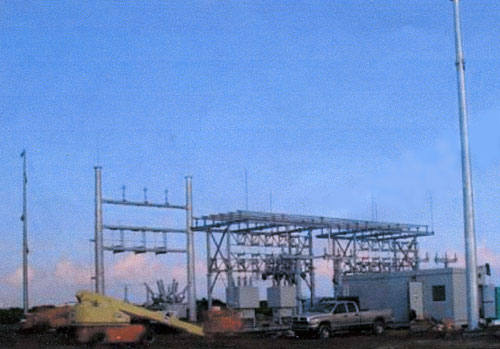
^Electrical substation connecting wind farm to main lines.
POD: FENCES AND SAFETY SIGNS: "Temporary fencing around unfinished turbine bases and excavations are designed primarily to warn people of the potential danger, and therefore this fencing is typically a high visibility plastic mesh. Permanent fencing will be chain-link with locked gates."
Our Response: Access will be a very big issue with a project this large. Many public land uses will have access cut off to areas they have been visiting for years.
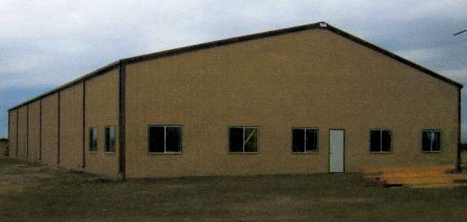
^Operations and maintenance building like the type that will be constructed for the Searchlight wind farm.
Land Use
POD: "The lands covered by the Wind Monitoring ROW and the privately held lands within the ROW boundary cover 26,000 acres or approximately 40 square miles. The total area estimated to be utilized by the wind energy facility (including temporary disturbance) is approximately 553 acres or 0.87 square miles. Therefore, the percentage of land including all facilities and temporary disturbance is estimated to comprise approximately 2.1% of the total ROW. The permanent footprint of the wind energy facility will only comprise 0.5% of the ROW. Large areas of open, undeveloped land will exist between the individual turbines. This space is necessary for the free-flow of wind, which results in efficient, safe, long-term operation of the wind turbine generators."
Our Response: This document indicates that disturbance could be much larger than this. The large areas of “undeveloped” land will be impacted by roads, Catamount’s off road vehicle use, trenches, meteorological towers and transmission lines.
POD: "The lands covered by the Wind Monitoring ROW and the privately held lands within the ROW boundary cover 26,000 acres or approximately 40 square miles. The total area estimated to be utilized by the wind energy facility (including temporary disturbance) is approximately 553 acres or 0.87 square miles. Therefore, the percentage of land including all facilities and temporary disturbance is estimated to comprise approximately 2.1% of the total ROW. The permanent footprint of the wind energy facility will only comprise 0.5% of the ROW. Large areas of open, undeveloped land will exist between the individual turbines. This space is necessary for the free-flow of wind, which results in efficient, safe, long-term operation of the wind turbine generators."
Our Response: Nothing in the POD addressed the impacts this will have on recreational access. Hiking, hunting and 4 wheel drive activities would be impacted by cut off access and impaired scenery.
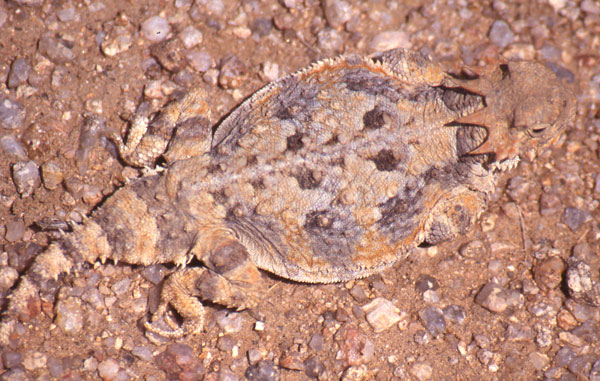
^Desert horned lizard (Phrynosoma platyrhinos).
Biological Resources
POD: "The following is a summary of data reviews and special status species that may occur within the vicinity of the right-of-way (ROW). Through the environmental review and permitting processes, a site specific plan for avoiding and/or mitigating impacts to these biological resources will be created. Project-specific avoidance and mitigation measures will be incorporated into the final design, the Environmental Impact Statement (EIS), and the Environmental Compliance Plan."
Our Response: This is a very incomplete summary. The BLM must require Catamount to do a much better and more comprehensive survey. We will give details.
POD: "Species listed or proposed for listing as threatened or endangered under ESA (50 CFR 17.12 for listed plants, 50 CFR 17.11 for listed animals, and various notices in the Federal Register [FR] for proposed species);
• Species that are candidates for possible future listing as threatened or endangered under ESA (67 FR 40657, June 13, 2002);
• Species that are federal species of concern;
• Species that are listed or proposed for listing by the state of Nevada as threatened or endangered (Nevada Revised Statute [NRS] 527.260-300 and NRS 527.060-120);
• Animal species fully protected in Nevada;
• Animal species of concern to the Nevada Division of Wildlife (NDOW) and NNHP; and
• Species designated as sensitive by BLM or a species of special management concern to BLM and managed specifically."
Our Response: BLM should include complete species lists in the EIS including species that are not on these lists.

^Black-throated sparrow singing from a cholla.
POD: "Plant communities present, potential habitat for special-status species, and presence or evidence of special-status species were noted when detected. It should be noted that the survey date was too early in the season for some annual and herbaceous perennial plants to be evident. Observations from the field visit are summarized herein."
Our Response: Surveys should be done in the correct seasons to get the most accurate information. Carefully look at the mitigation measures - sometimes they just say 'this cannot be mitigated' and you are up a creek without a paddle. Or they will let them buy land out in the toolies somewhere and let it go at that.
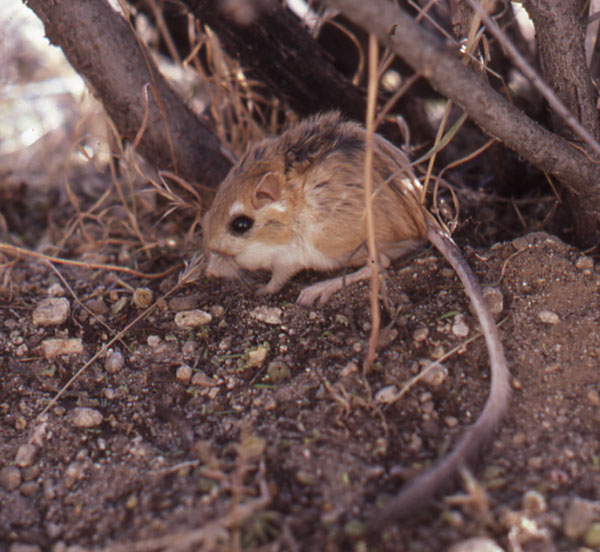
^Merriam's kangaroo rat (Dipodomys merriami), a common nocturnal denizen of the desert.
Desert Tortoise
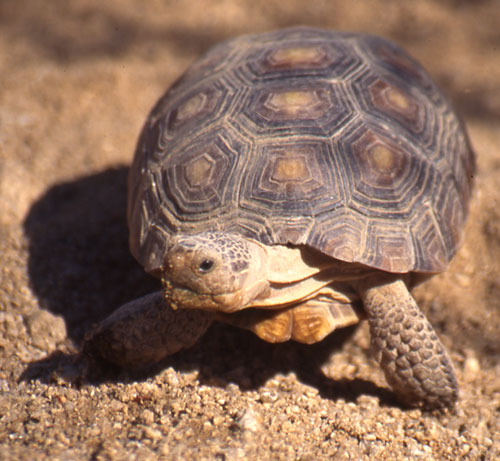
POD: Federally-Listed Species: Desert Tortoise (Gopherus agassizii).
"The desert tortoise was listed by the U.S. Fish and Wildlife Service as a threatened species under the federal Endangered Species Act (ESA) on April 2, 1990. In addition, as Nevada’s state reptile, the desert tortoise is considered a state protected and state threatened species.
During the initial field survey associated with meteorological tower ROW permitting, one desert tortoise burrow was observed within the ROW, approximately 750 feet southwest of the proposed location for meteorological tower 2 (Section 25 in T28S R63E). The potential for desert tortoise to be encountered in the ROW is considered to be high due to the favorable topography, proximity of creosote desert scrub habitat, and proximity to USFWS-designated critical desert tortoise habitat within the Paiute-El Dorado Valley Area of Critical Environmental Concern (ACEC), which borders the proposed Searchlight Wind Energy Facility ROW."
Our Response: There is very little information here on the issues and mitigation measures that are required information for a project this large. An initial field survey around a meteorological tower is not nearly enough to get an idea of the impacts that such a disturbance might have.
The project symmetrically borders the Piute-El Dorado Valley Area of Critical Environmental Concern (ACEC). It is not really clear from the maps provided how much actual disturbance will occur inside the ACEC. Right of way access, transmission lines, trenches for buried lines, meteorological towers, and actual wind turbines may actually be required to use the ACEA to make this project viable. Categorical Exclusions may be required to use the ACEC for access and limited development. The amount of development in the ”keyhole” boundary of the ACEC that the project completely requires will have obvious impacts to tortoise populations in the bordering ACEC as well as for the tortoises in the project area.
Such impacts would be:
1. Towers, transmission lines, still wind turbines and other structures will become perches for predatory ravens. How will Catamount minimize this impact? Will poisons and predator control be used to kill ravens?
2. Obvious direct impacts to tortoises and habitat will occur from trench digging, blasting, road development, Catamount’s use of off road vehicles, crane routes, layout pads and other disturbances.
3. Fences will fragment habitat and connectivity for tortoise populations.
4. Individuals on neighboring ACEC lands will wander into the project area.
5. Stress from development and movement of tortoises could contribute to upper respiratory tract disease (URTD) and certain shell diseases.
6. Developments and other disturbances to the landscape will create spread of invasive weeds which will create potential wildfire threats to the animals after wet years. Wind turbines can act as lightning rods, creating an even greater threat of wildfires. Invasive weeds also choke out native plants that are food sources for tortoise. Non-native weeds compromise the nutritional intake of tortoises. If herbicides are used as control, what herbicides will be used and how safe are they?
7. New access roads and developments by Catamount may give easier access to those who would release diseased captive tortoises into the area.
Where will tortoises from the project area be translocated to? Will this be an area where other native tortoises live? How will this situation be handled? Will tortoise-exclusion fencing be placed along the permanent fence?
Gila Monster
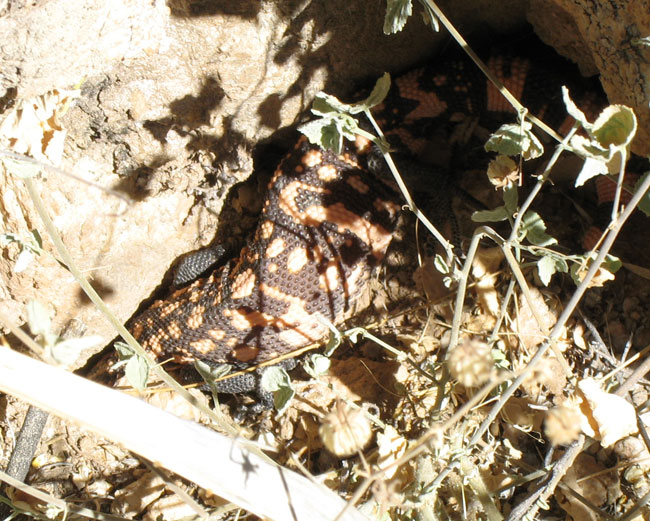
POD: Special-Status Animal Species: Banded Gila Monster (Heloderma suspectum ssp. cinctum).
"The banded Gila monster is a Nevada state-protected and BLM sensitive species. The banded Gila monster is common in areas with Saguaro cactus and along washes at elevations from near sea level to 4,100 feet. It occurs in southwestern Utah, the southern tip of Nevada, southwestern New Mexico, Arizona, and in Sonora, Mexico primarily in the Mojave Desert scrub and salt desert scrub ecosystems. The banded Gila monster usually uses burrows excavated by other animals, but can dig its own burrow. They live in heavy brush, rocky brushy wash beds, and/or along canyon bottoms....Initial field survey associated with meteorological tower ROW permitting did not result in the identification of any individuals of this species, nor of any sign of their presence." Population density said to be "low."
Our Response: As BLM should know the Gila monster is a fossorial species that is very difficult to locate. It is very presumptuous for Catamount to claim that the densities are low based on a small survey centered around a meteorological tower. Populations of this species in the Mojave Desert are fringe populations and could carry unique genetic bottleneck traits that should be researched.
We contacted Dr. Daniel Beck of Central Washington University, who is the leading authority on the biology of helodermatid lizards (see his website >>here). We explained the project to him and showed him the map of the project. This is his response:
“As you know it is extremely difficult to make accurate population estimates of Gila monsters, especially in the Mojave Desert, where they are even less frequently active than in the Sonoran Desert. Some sites in the eastern Mojave desert contain population densities of up to 20 lizards/square mile. I know of sites in southern Nevada that contain fairly high densities as well, perhaps as high as 10-15/square mile (just an estimate). High densities are associated with sites that have relatively high topographical complexity (lots of topographical relief, boulders, burrows, and potential shelters for Gila monsters). Sandy areas bordering rocky outcrops are good habitat areas. Based on the map from the link you sent, it looks like such habitat features likely exist at the proposed windfarm site near Searchlight. So, I'd advise decision makers not to assume the absence of Gila monsters based on short-term surveys.”
The BLM needs to have qualified individuals do a complete survey of the area for the species before the occurrence of the species is considered “low”.
Chuckwalla
"The chuckwalla is a state-protected and BLM special status species. The Chuckwalla inhabits open flats and rocky areas, often near large rocks and boulders....Initial field survey associated with meteorological tower ROW permitting did not result in the identification of any individuals of this species, nor of any sign of their presence." Population said to be "low."
Our Response: Anyone familiar with the Mojave Desert knows that chuckwallas occur in extreme southeastern Nevada in rocky outcrops. It is difficult to believe that none were spotted, yet there is little description of the landscape around the meteorological tower or what time of year the survey was done. BLM will have to conduct a survey that covers the area during the proper season. It is not scientific to make such empty assumptions.
Bat Mortality
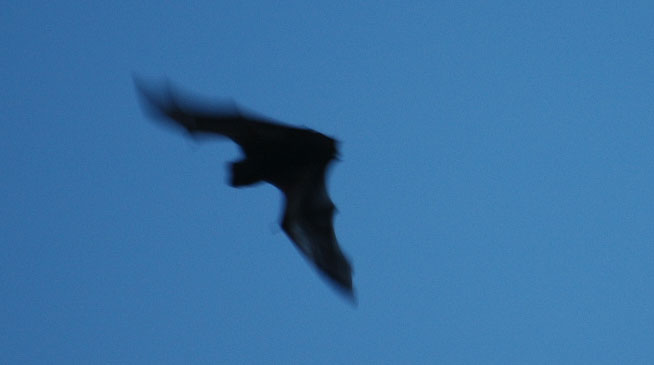
^Hoary bat flying at dusk.
POD: Townsend’s Western Big-eared Bat (Corynorhinus townsendii).
"Townsend’s western big-eared bat is a BLM sensitive species found throughout Nevada, from low desert to high mountain habitats. This species is often found in areas offering caves or mines as roosting sites. Historical mining operations in the Searchlight vicinity have created many open mining shafts for potential occupation, but few other habitat features such as open water are known to occur within the ROW. Therefore, the Townsend’s western big-eared bat is not expected to inhabit the ROW in significant numbers."
Our Response: Open water is not a requirement for this species and there is much water close by in Lake Mead National Recreation Area. The possibility of the species occurrence is high. This assumption is not scientific.
This is the complete list of bat species that should be considered in the EIS:
Pallid bat (Antrozous pallidus)
Townsend’s big-eared bat (Corynorhinus townsendii)
Big brown bat (Eptesicus fuscus)
Spotted bat (Euderma maculatum)
Greater western mastiff bat (Eumops perotis)
Allen's lappet-browed bat (Idionycteris phyllotis)
Silver-haired bat (Lasionycteris noctivagans)
Western red bat (Lasiurus blossevilli)
Hoary bat (Lasiurus cinereus)
California leaf-nosed bat (Macrotus californicus)
California myotis (Myotis californicus)
Small-footed myotis (Myotis ciliolabrum)
Long-eared myotis (Myotis evotis)
Little brown myotis (Myotis lucifugus)
Fringed myotis (Myotis thysanodes)
Cave myotis (Myotis velifer)
Long-legged myotis (Myotis volans)
Yuma myotis (Myotis yumanensis)
Big free-tailed bat (Nyctinomops macrotis)
Western pipistrelle bat (Pipistrellus hesperus)
Brazilian free-tailed bat (Tadarida braziliensis)
Far more species of bats could occur in the project area that is even on this list. Most of them are on some kind of sensitive list. As BLM should be aware, there are several studies that have proven that industrial wind farms increase bat mortality by disrupting sonar.
From the US Geological Survey web site (>>here): “In the push to develop new forms of sustainable energy, the wind power industry is at the forefront....However, recent evidence shows that certain species of bats are particularly susceptible to mortality from wind turbines. Bats are beneficial consumers of harmful insect pests, and migratory species of bats cross international and interstate boundaries. Dead bats are turning up beneath wind turbines all over the world. Bat fatalities have now been documented at nearly every wind facility in North America where adequate surveys for bats have been conducted, and several of these sites are estimated to cause the deaths of thousands of bats per year. This unanticipated and unprecedented problem for bats has moved to the forefront of conservation and management efforts directed toward this poorly understood group of mammals. The mystery of why bats die at turbine sites remains unsolved. Is it a simple case of flying in the wrong place at the wrong time? Are bats attracted to the spinning turbine blades? Why are so many bats colliding with turbines compared to their infrequent crashes with other tall, human-made structures?”
In West Virginia, surveyors found 2,000 dead bats of seven species around 44 wind turbines atop Backbone Mountain during 61 days of surveys. The actual bat kill numbers are probably closer to 4,000, according to Merlin Tuttle, director of Bat Conservation International in Austin, Texas, after she took a closer look at the methods and data provided by the private consulting firm hired by the windfarm company. The methodology of many bat and bird surveys around wind farms has been flawed and seriously underestimates the numbers of bats killed, she said. (See the story >>here)

^Silver-haired bat resting in a Fremont cottonwood in a desert oasis during migration.
Bird Mortality
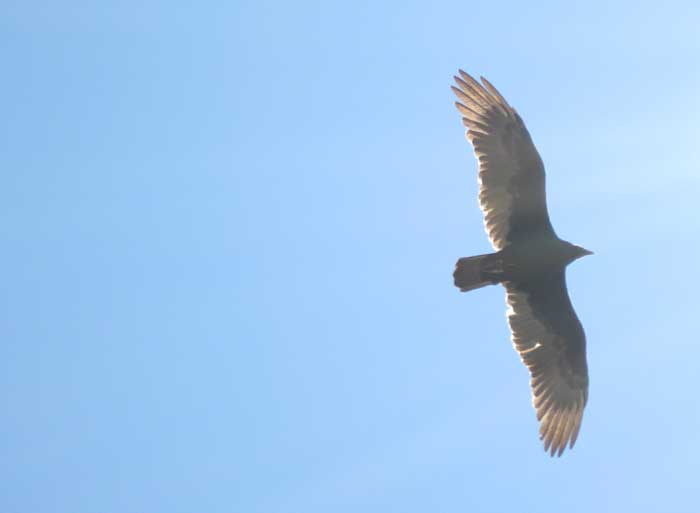
^Turkey vulture, a common desert migrant.
It is well known that industrial wind turbines have significantly contributed to bird mortality. The Plan of Development says little if anything about this very important subject. Listed below are some of the details that need to be included in the EIS. The project area is located very close to Lake Mead which is a very important habitat for many species of birds. How will this be minimized? If the project is approved who will count the fatalities? How can you be sure that the counts will be accurate? Can the fatalities be counted before scavengers take the carcasses?
The 2.3 MW Siemens SWT-2.3-93 turbines proposed for use at Searchlight, with a tower height of about 240 feet (80m), and turbine radius of approximately 140 feet. These have been shown to kill many birds due to the speed of the tip of the blade when turning. The 2.5-megawatt machines proposed for Sheffield and Sutton, for example, have a 256' tower plus a 162' blade radius (with a tip speed of 168 mph) (Eric Rosenbloom, October 31, 2006 [revised August 8, 2007], www.aweo.org) .
BIRD MORTALITY ESTIMATES:
(Much of this information was obtained from www.iberica2000.org, which also has many photos of bird kills at wind farms in Spain and Portugal)
Altamont Pass, Alameda County, California:
The largest wind turbine concentration in the world, Altamont Pass has over 4900 relatively small wind turbines of various types. It has a capacity of 576 megawatts (MW), producing about 125 MW on average and 1.1 terawatt-hours (TWh) yearly.
Several studies showed an on-going massacre at this very large windfarm in the Interior Coast Range of Alameda County, California. In 2002 ornithologist Grainger Hunt estimated, very roughly, that golden eagles were being killed at the rate of 40 to 60 per year.
(W. Grainger Hunt et al., Golden Eagles in a Perilous Landscape: Predicting The Effects Of Mitigation For Wind Turbine Blade-Strike Mortality, University of California, Santa Cruz. California Energy Commission Report, 2002.)
An in-depth study, performed by Dr. Smallwood, puts the golden eagle mortality rate at 116 per year, once adjusted for detection and scavenging. (Developing Methods To Reduce Bird Mortality In The Altamont Pass Wind Resource Area - Dr. Smallwood & K. Thelander, Aug. 2004. Also available here: http://www.energy.ca.gov/pier/final_project_reports/500-04-052.html).
Altamont attracts young eagles from all over California, as dead territorial eagles are replaced by the newcomers, who get killed in turn. The windfarm acts as a black hole, a population sink for eagles in the Western United States due to its incredible richness of rodent populations in arid grasslands.
At the estimated rate of 116 per year, in excess of 2,000 eagles would have been killed by the turbines over 20 years.
Dr. Smallwood said, "It appears that factors other than tower type play more of a role in whether a particular turbine is associated with one or more fatalities, such as prey distribution about the tower’s base, physical relief, and presence of declivity winds. Regardless, the number of fatalities at tubular towers was higher than at horizontal lattice towers".
"Adjusting for local relative abundance, the existing data indicate that most wind energy generating facilities have an equal impact on the local raptors."
(Developing Methods To Reduce Bird Mortality In The Altamont Pass Wind Resource Area - Dr. Smallwood & K. Thelander, Aug. 2004. Also available here: http://www.energy.ca.gov/pier/final_project_reports/500-04-052.html).
Altamont also kills other raptors: at least 500 hawks, owls, falcons, harriers, and kites per year ( 2003 Report - K. Shawn Smallwood, Carl Thelander, and Linda Spiegel
Raptor Mortality at the Altamont Pass Wind Resource Area. Research funded by the National Renewable Energy Laboratory. Also available here: www.iberica2000.org/documents/EOLICA/ALTAMONT/Dr.Smallwood_presentation.pdf ).
Cumulatively, that equals 10,000 "protected" raptors over 20 years says Dr. Smallwood.
Other birds killed by these turbines include doves, larks, ducks, blackbirds, gulls, swallows, herons, ravens, passerines, and bats ( Report - Thelander, C. G,Smallwood, K.S., Rugge, L. - Bird Risk Behaviors and Fatalities at the Altamont Pass Wind Resource Area - March 1998-December 2000, National Renewable Energy Laboratory Report SR-500-33829, December 2003. Also available here: www.nrel.gov/docs/fy04osti/33829.pdf).
See Darryl Mueller's photos of dead eagles at Altamont Pass >>here.
San Gorgonio, Riverside County, California:

^Aerial view of part of the San Gorgonio wind farm (Courtesy Matthew Field, www.photography.mattfield.com).
As of January 2008 San Gorgonio wind farm consists of 3,218 turbines delivering 615 MW. A single Southern California Edison 500 kV power line crosses the area, linking Los Angeles with the Palo Verde Nuclear Power Plant in Arizona.
Raptors and waterbirds are killed here, but a study by McCrary (1986) evidenced that passerines were also being killed in numbers: "an overall estimate of as many as 6,800 birds killed per year, most of them nocturnal passerine migrants." (www.iberica2000.org/documents/EOLICA/6800_bird_fatalities.doc)
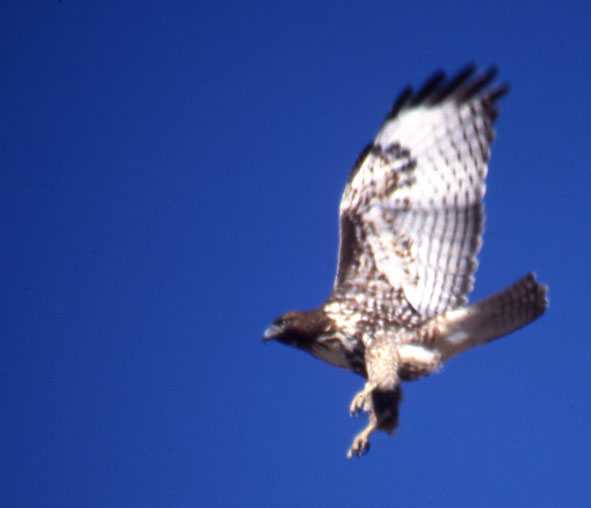
^Red-tailed hawk.
Cordelia, Solano County, California:
S. Byrne monitored a solitary wind turbine for one year, starting in 1992: "The mortality adjusted for scavenger removal and detectability suggests an actual mortality during the study as high as 54 birds." (Byrne, S. 1983. Bird movements and collision mortality at a large horizontal axis wind turbine. Cal-Neva Wildlife Transactions: 76-83. This study was conducted as a part of Pacific Gas and Electric Company´s performance monitoring program for a Boeing MOD-2 wind turbine)
This is similar to European findings of 20 to 60 birds/turbine/year.
Tucker, Backbone Mountain, West Virginia:
As required by the state Public Service Commission, the wind power site owners, FPL Energy, hired a private consulting firm to study bird and bat deaths in the first year after the 44 turbines went into operation. 200 dead birds were found on 61 field days walking around the turbines. Almost half were Red-eyed vireos, migrating along the ridge. Robins, Indigo buntings, one red-tailed hawk, and two turkey vultures were also found. Researchers found 33 dead birds on one night, attracted by bright sodium vapor lights on the outside of an electrical substation on a foggy night. Currently there are no siting regulations for placing wind farms on major bird flyways. The West Virginia Highlands Conservancy, after much debate, agreed not to fight a proposed wind project in 2002, but asked the Public Service Commission to set up a process for determining good sites. Some of its members have formed splinter groups to oppose wind energy projects. Wind power has divided the environmental community. (From the article >>here)
Germany:
Bernd Koop, based on monitoring studies conducted in Holland by Winkelman, estimated there would be 60,000 to 100,000 bird collisions per 1,000 megawatt installed capacity in his country per year (Koop B., 1997. Vogelzug und Windenergieplanung. Beispiele für Auswirkungen aus dem Kreis Plön (Schleswig-Holstein). Naturschutz und Landschaftsplanung 29 (7): 202-207.).
Birds also die in large numbers from collisions with 70,000 km of high-tension lines that crisscross the country - 30 million birds per year is an extrapolation found in Hoerschelmann, Haack & Wohlgemuth, based on a study along 4.5 km of high tension lines - electrocutions excluded (Hoerschelmann, Haack & Wohlgemuth (Ecol. Birds 10, 1988: 85-103; German text, English summary).
The Netherlands:
A study in 1992 at Urk and Oosterbierum estimated mortality from wind farms to be somewhere between 33,500 and 195,500 birds per 1,000MW (Winkelman J.E., 1992a - De invloed van de Sep-proefwindcentrale te Oosterbierum (Fr) opvogels - aanvaringsslachtoffers - section 5.6.8. De invloed van de Sep-proefwindcentrale te Oosterbierum (Fr) op Instituut voor Bos- en Natuuronderzoek (IBN-DLO), Arnhem).
Sweden:
In 1983, on a foggy night in Sweden, a single wind turbine killed 49 birds (J.Karlsson, Vindkraft Faglar publication).
Navarre, Spain:
In 2001, a report commissioned by the local government gave evidence that one third of the wind turbines in the region had made 7,150 victims in one year, including 409 griffon vultures, 24 eagles and other raptors, 650 bats, and over 6,000 small birds, 40% of them migrants. Thus 368 turbines = 20 victims/turbine/year. (Jesus Lekuona, 2001, Flight Patterns and Evaluation of Bird and Bat Mortality in the Windfarms of Navarre During and Annual Cycle. General Management of the Environment, Environmental Department, Land Use and Housing, Government of Navarre).
Bulgaria:
The Bulgarian Society for the Protection of Birds launched a petition to save their migrating birds from a windfarm project.
Searchlight Wind Farm Potential Future Kill:
This is a list of birds that will potentially be impacted by the Searchlight project. These need to be included in the EIS:
Golden eagle
Bald eagle
Osprey
Red-tailed hawk
Red-shouldered hawk
Swainson’s hawk
Ferruginous hawk
Rough-legged hawk
Prairie falcon
Peregrine falcon
Kestrel
Merlin
Northern harrier
White-tailed kite
Turkey vulture
Loons
Great-blue heron
Snowy egret
Great egret
Sandhill crane
Sandpipers, shorebirds migrating
Ducks, geese, swans – according to Bellrose 1980, the Searchlight area is along the Colorado River migration corridor for geese and ducks between Salt Lake and Canada, south to Mexico. (Bellrose, F. 1980. Ducks, Geese, and Swans of North America. Wildlife Management Institute, Stackpole Books: Harrisburg, PA).
Gulls
Mourning dove
White-winged dove
Common poorwill
Lesser nighthawk
Common nighthawk
Great-horned owl
Burrowing owl
Long-eared owl
Short-eared owl
White-throated swift
Vaux’s swift
Hummingbirds in migration
Common raven
Swallows
Horned lark
Red-winged blackbird
Brewer’s blackbird
Great-tailed grackle
Nocturnal passerine migrants/Neotropical passerines
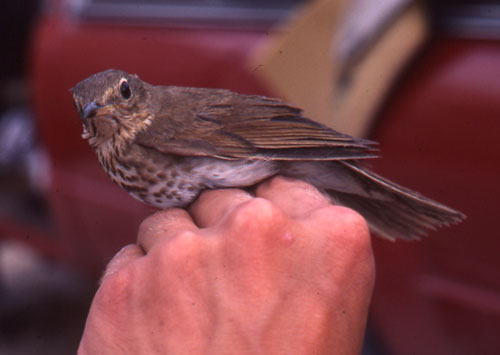
^This migrating Hermit thrush was caught in a mist net during a University of California at Berkeley field survey in the Mojave National Preserve, adjacent to the Searchlight region. Passerine birds like this commonly pass through seemingly arid deserts on spring and fall flights.
Plant Communities
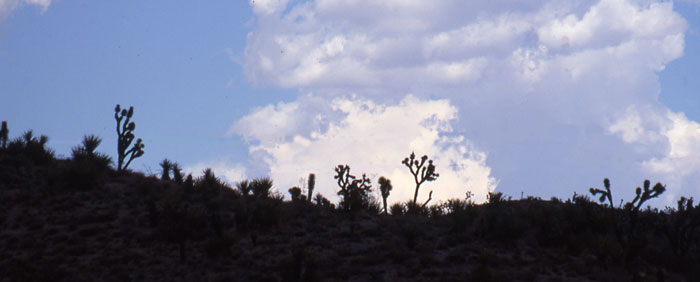
^Joshua trees (Yucca brevifolia) on hills by Searchlight.
POD: "The proposed Searchlight Wind Energy Facility ROW is characterized by flat to heavily dissected topography and by high desert plant communities. Surface disturbance ranges from minimal to heavy, with vegetation being rather sparse in disturbed areas. The ROW consists primarily of mixed scrub dominated by creosote bush, in loose associations with other shrub species.... Joshua Tree Woodland, blackbush scrub, and yucca also are common within the ROW..."
Our Response: The southern Mojave Desert is a very unique biome. Much of it has been lost to large scale development and urbanization. It contains many unique and endemic species. A project like this will produce little energy, create only 15 full time jobs and does not justify the destruction of this much habitat.
Noxious Weeds
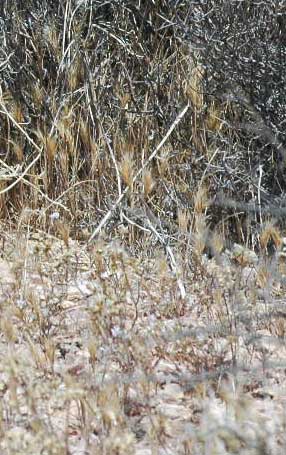
^ Red Brome, an invasive weed introduced from the Mediterranean region.
POD: "Noxious weeds are defined by the State of Nevada as 'Any species of plant which is, or liable to be, detrimental or destructive and difficult to control or eradicate...'(NRS 555.005). The noxious weed species of primary interest to the BLM Las Vegas Field Office are listed..." as 47 plant weeds, including such species as Spotted knapweed (Centaurea masculosa) and Green fountain grass (Pennisetum setaceum).
Our Response: The large amount of land disturbance will expedite the spread of non native invasive plants. Wind turbines will attract lightning during storms and have the potential to create more wildfires. How will BLM control the weeds? Will herbicides be used? What herbicides will be used? How will these impact native plants? How will herbicide affect wildlife and local water quality? An increase in weedy Red brome (Bromus madritensis var. rubens) can negatively affect Desert tortoise nutrition and habitat characteristics.
Archaeological and Historical Resources
POD: "According to Section 106 of NHPA, 'an undertaking has an effect on a historic property when the undertaking may alter characteristics of the property that may qualify the property for inclusion in the National Register' (36 CFR 800.9[a]). An effect is considered adverse when the effect on an NRHP-eligible property may diminish the integrity of the property’s location, design, setting, materials, workmanship, feeling, or association. Adverse effects on historic properties include, but are not limited to, the following."
Our Response: Nothing in the document indicates that Catamount has even bothered to survey these resources. Because this area is so close to the Colorado River, it is rich in rock art sites, and other prehistory sites. Catamount should be required to hire qualified individuals to conduct a full inventory. The site is also rich in historical mining sites. If the project is approved, these resources will be lost forever.
Traditional Culture
POD: Native American Consultation: "Pursuant to NEPA, NHPA, or state requirements, Native American Consultation shall be initiated early in the decision making process. BLM will conduct government-to-government Native American consultation."
Our Response: What tribes in the area will be affected by this? There is no information. This should be outlined in detail.
Visual Quality
POD: "In order to meet its responsibility to maintain the scenic values of the public lands, BLM has developed a Visual Resource Management (VRM) system. The VRM inventory stage involves identifying the visual resources of an area and assigning them to inventory classes using BLM’s visual resource inventory process. The process involves rating the visual appeal of a tract of land, measuring public concern for scenic quality, and determining whether the tract of land is visible from travel routes or observation points. The process is described in detail in BLM Handbook H-8410-1, Visual Resource Inventory. Visual resources are then assigned to management classes with established objectives."
Our Response: This ranking system is arbitrary and means little to those of us who find the region scenic. We do not need the BLM telling us what we think is beautiful. The turbines and transmission lines will be visible from the highway, from most of the town of Searchlight. From the wilderness of Lake Mead National Recreation Area. There will be less wildlife viewing opportunities.
POD: "Turbines are also planned for skyline ridges and hilltops, where there would be higher visual contrast and lower visual absorption capability. The existing landscape has been modified through past and current human habitation, highway and roadway development, mining activities, the establishment of transmission line corridors, and other anthropogenic activities."
Our Response: There is nothing in the POD that addresses the negative impacts the visual disturbance will have on tourism or the quality of life of the residents of Searchlight.
We would also like to know what type of light or strobe lights will be placed on the tower tops for aviation visibility. Will they be lighted day and night? What affect will these new lights have on wildlife and he viewscape of the desert wildlands around?
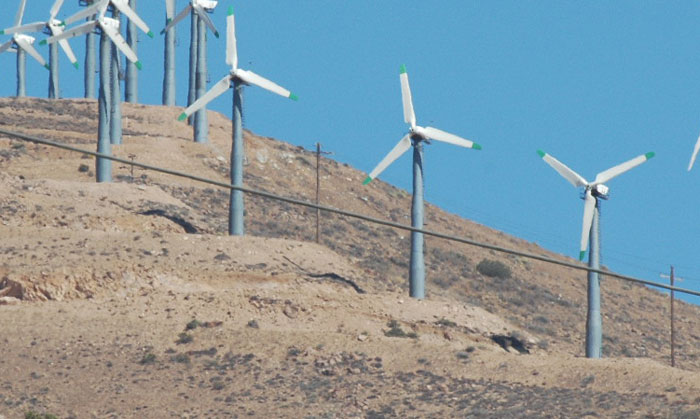
Noise
POD: "The project will comply with all Federal, State and Clark County requirements with respect to noise levels during construction and operation. Through future environmental review and permitting processes, a site specific plan for avoiding and/or mitigating noise impacts will be created. Project-specific avoidance and mitigation measures will be incorporated into the final design, EIS, and Environmental Compliance Plan."
Our Response: The EIS will not only need to address the obvious disturbances caused by blasting and heavy machinery during construction, but the noise of spinning turbines affecting quality of life of local residents, people using adjacent public lands and impacts on wildlife. Many people who live next to industrial wind farms complain about the noise all of the time. See this article in USA Today >>here.
Noise levels from wind farms have caused stress, lack of sleep, migraines, dizziness, and disorientation. Researchers in Portugal have found that conditions for developing vibroacoustic disease exist in homes near wind turbines. A set of symptoms called "wind turbine syndrome" has been extensively documented by Dr. Nina Pierpont in the U.S. Airplane safety lights at night and strobing shadows when the sun is low add to the turbines' invasive presence (Eric Rosenblum, www.aweo.org). The French Academy of Medicine and the U.K. Noise Association say that large wind turbines should not be closer than a mile from any residence.
Air Quality
POD: "After completion, the turbine project will generate electricity without air pollution and is expected to result in the overall reduction of an estimated 575,000 tons of Carbon Dioxide, 900 tons of Nitrogen Oxide, and 600 tons of Sulfur Dioxide per year compared with electricity generated by the average fuel mix for the region in which the project is to be located."
Our Response: While the wind energy itself will not produce carbon emissions, any backup sources used to produce energy when the wind is not blowing will. Plus, there is no proof that this wind farm will stop the use of other conventional energy that will cause the emissions listed here.
Oil Spills and Leaks
POD: OIL SPILL PREVENTION: "The wind turbines will typically use four lubricating oils and greases, none of which contain any compounds listed as hazardous by the Environmental Protection Agency. These are used in moderate quantities and are contained entirely within the spill trap and nacelle so that the possibility for accidental leakage is minimal. Lubricating oils are checked quarterly and filled and changed as needed. Spent oils will be recycled with a certified waste contractor. The oil change will be performed up-tower where any accidental spills will be contained by the nacelle. Small amounts of oils and greases will be stored in the operations and maintenance building on site in special containers. All special wastes, including waste oils and contaminated rags, etc., will be removed from site using a controlled waste manifest. All waste materials will be disposed of via a licensed waste carrier who shall deliver the material to a licensed waste disposal site."
Our Response: Large turbines may contain 180 to 200 liters of oil in bearing seals, oil-supply lines, cooler tube joints, and valve connections into ground – when leaks happen, a specialist firm must be called to clean it up. According to Erich Hau ( in Wind Turbines: Fundamentals, Technologies, Application, Economics, Second edition, Springer), gearboxes still have many problems with leakages.
Are the turbine oils mineral oil or synthetic? What measures will be taken to clean up any leaks that may affect bighorn sheep or tortoise habitat? An oil leak at Pickering, caused by a crack on a Hydraulic cylinder weld, spewed a fine mist of oil at high pressure 200m away. Would this cause toxins to get into sensitive wildlife habitat? What would the impacts on groundwater be? Would there be chemical pollution?
Water
How much water will be required for construction, dust control and operation of the entire project? How will water be used? Why was this not covered in the plan? Where will the water come from? How will this impact water rights, property values and ecology? Is there even enough water in the area to sustain such a large project?
Local Economics
There is no information on the advantages or disadvantages that the project will create for local people. A newspaper article in the Las Vegas Review Journal (>>here) claims the project will cost $600 million and create only 15 full time jobs. These jobs are very specialized and are not likely to be given to local people. Servicing wind turbines is a very specialized field, and factory training and updates are essential to doing a good job. There are not yet third-party service organizations for wind turbines. For example, Vestas looks after and services its turbines (http://www.biofuels.coop/windblog/?p=20).
Southern Nevada union leaders complained that Nevada Solar One, Boulder City's first solar thermal power plant built by the Spanish company Acciona Energy, promised to hire local Nevada workers but instead hired workers from Central America "at a fraction of the cost." Councilwoman Linda Strickland said that if the city required in its contract the companies use local labor, it would be difficult to enforce. (See our story >>here.)

^Construction of a turbine foundation.
Macroeconomics
According to Scientific American Earth 3.0 (Vol 18, No 5, 2008), 49% of US energy generation comes from coal, 20% from natural gas, 19% from nuclear, 7.3% from hydroelectric, and 3.5% from renewables. A single 555-megawatt natural gas-fired power plant in California generates more electricity in a year than do all 13,000 of the state's wind turbines. How will the rather inefficient wind industry catch up? Answer: throw money at it (our tax money).
The stated amount of electricity generation by wind farms is usually far less in real conditions. In the UK, for example, the average yield (load factor) of wind power was just 25.4% for 2003-4 (Dr John Etherington 2006, www.iberica2000.org).
From the Dow Jones News Wire, January 15, 2009: "House lawmakers are proposing to give solar and wind energy producers billions in government grants instead of tax credits to build renewable energy capacity, potentially transforming the way renewable energy projects have been financed for years. The new grant program, which will be administered by the Department of Energy, is part of House economic stimulus legislation announced Thursday, details of which are still emerging. The new funding, which temporarily replaces the tax credit that wind and solar projects have long relied on with direct government spending, underscores President-elect Barack Obama's commitment to double renewable electricity production in three years." The House stimulus bill would extend the production tax credit for wind by three years. (See the story >>here.)
Glenn Schleede explains the Federal Production Tax Credit this way: a "generous federal subsidy available to 'wind farm' owners is the Production Tax Credit of $0.019 per kWh of electricity generated during the first 10 years of a wind project's life. For example, at the current rate of $0.019 per kWh, owners of the proposed 150 MW Elk River 'wind farm' in Butler County would receive a tax credit (i.e., a direct deduction from its federal income tax bill) of $9,986,400 per year if the turbines produce at an average 40% capacity factor (i.e., 150,000 kW x 8760 hrs. × .40 × $0.019). The rate, originally set at $0.015 per kWh, has just been adjusted upward for inflation, reaching $0.019 per kWh, retroactive to January 1, 2005. Organizations owning 'wind farms' must have substantial taxable income from other sources to take advantage of the two federal tax shelters described above. That is one reason why small 'wind farm' development companies often sell off their projects to larger companies or find ways to 'sell' the tax benefits. " (www.aweo.org, "Big money" discovers the huge tax breaks and subsidies for wind energy while taxpayers and electric customers pick up the tab, Glenn Schleede, April 14, 2005).
We wonder how expensive this will get. As noted above, wind power today must be backed up with coal. In Scotland "a leading power company has claimed wind energy is so unreliable that even if 13,000 turbines are built to meet EU renewable energy targets, they could be relied on to provide only 7 per cent of the country's peak winter electricity demand. [The power company] E.On has argued that, during the coldest days of winter, so little wind blows that 92 per cent of installed wind capacity would have to be backed up by traditional power stations. It argues this would require new coal-fired power stations to be built so they could be used in an emergency when little wind blows. This, E.On suggests, will mean that, to meet renewable targets of 20 per cent of energy being provided from renewables by 2020, the UK's installed power base will need to rise from 76 gigawatts today to more than 100GW. The company estimates this could cost £100 billion. The John Muir Trust, which campaigns against wind farms in Scotland's beauty spots, said E.On's claims back its view that the country is depending too heavily on wind power. Helen McDade, the trust's policy officer, thinks instead far more should be done to improve energy efficiency. 'Energy conservation is by far the best use of money,' she said. 'The question is why we are not doing more of this.'" (See the story at news.scotsman.com >>here.)
Property Rights and Property Values
^Private residences checkerboarded in between turbines at the San Gorgonio wind farm, Coachella Valley, California. Note the electrical substation at the upper right (Courtesy Matthew Field, www.photography.mattfield.com)
The obvious impacts to the scenery and complete change of the landscape could degrade the quality of life and property values of the people that live in the local region. The private lands checker boarded in the project area will no doubt be changed forever. This should be addressed in the EIS.
Grazing allotments and small mines.: How many of these are in the project area?
Recreation and access. This seems to be a big give-away of public lands to one user and there is no information on how this will affect hunting, hiking and general recreational access.
POD: “The proposed project will be located on lands administered by the BLM, as well as private lands. Due to the early stage of project development, not all private landowners potentially included in the project, including those shown to have turbines proposed for their properties, have been contacted. Catamount is currently investigating these lands for development potential, and the information and maps presented herein will be modified as additional information regarding private land inclusion becomes available. “
Our Response: We find it difficult to fathom that BLM would actually accept a plan by an energy company that did not even bother to resolve the issue of private lands checker-boarded throughout the project area. What will BLM and Catamount do if the landowners want nothing to do with the project? Is property seizure on the table here? How will the land owners feel about the massive disturbances this project will have on their property? Why was this not even considered? This is one of the more unprofessional actions we have seen the BLM take in a long time.
Eric Rosenbloom makes a good point about the deeper implications of land rights: "Rural America is no different to these companies than indigenous communities or 'third-world' countries. Enrich a few of the natives, persuade others of your 'progressive' intentions, pay for a school or firetruck, pit the rest against each other, and take what you want. In Australia, the Point Pierce Aboriginal community lost 40,000 years of Dreaming (which is, like Vermont's ridgelines, otherwise protected) to the construction of an industrial wind facility. Similarly, in New Zealand the Maori protest the desecration of sacred mountains. In India, the forests of the indigenous Adivasis are being taken for wind development. Besides the offense of allowing industrial wind development in protected forests, the new heavy-duty roads are opening them up to illegal logging. In Mexico, wind companies -- led by Spain's Iberdola -- have divided the Zapotecas on the Isthmus of Tehuantepec, the most important bird flyway on this side of the world. Some of the Zapotecas wrote about the wind companies to a Scottish bird protector who lives in Spain, describing 'the imposition of neoliberal megacorporations destroying nature and our cultures.' That is what is happening right in our own back yard " (www.aweo.org, 'Exploitation and destruction: some things to know about industrial wind power,' October 31, 2006 [revised August 8, 2007] ).
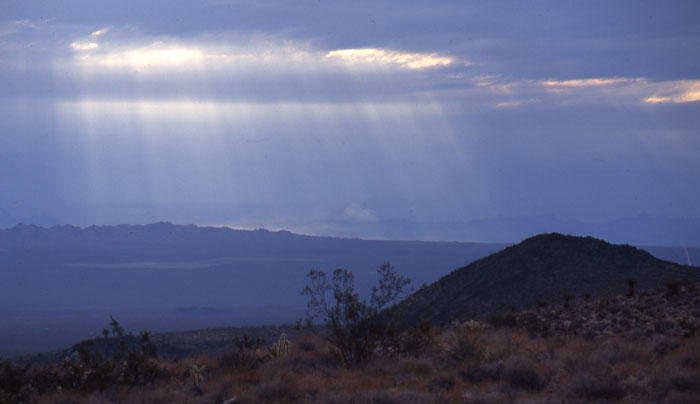
^View of the Searchlight area and the Piute-ElDorado Area of Critical Environmental Concern, from Mojave National Preserve.
Conclusion
While we believe in the potential of alternative energy, we feel the environmental benefits of clean energy become insignificant when the environmental footprint becomes as large as the one this project will leave on the landscape. This energy is better utilized by using roof top solar and previously developed areas near urban infrastructure. The BLM needs to be responsible when they are confronted with such environmentally devastating projects. This project is clearly not worth it given the small amount of energy it will produce, the vast cost and the unavoidable impacts to the landscape and local people that it will inflict.
HOME..........Searchlight Wind Project..........Town vs. Big Wind
